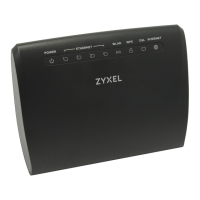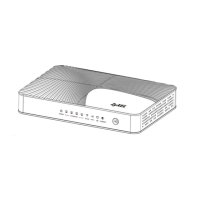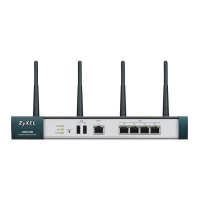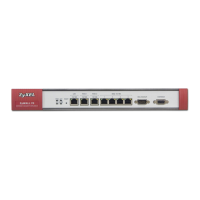Chapter 10 Firewalls
AMG1302-T10A User’s Guide
143
The following table describes the labels in this screen.
10.3 The Firewall Rule Screen
Note: The ordering of your rules is very important as rules are applied in turn.
Table 51 Security > Firewall > General
LABEL DESCRIPTION
Active Firewall Select this check box to activate the firewall. The Device performs access control and
protects against Denial of Service (DoS) attacks when the firewall is activated.
Bypass Triangle
Route
If an alternate gateway on the LAN has an IP address in the same subnet as the Device’s
LAN IP address, return traffic may not go through the Device. This is called an
asymmetrical or “triangle” route. This causes the Device to reset the connection, as the
connection has not been acknowledged.
Select this check box to have the Device permit the use of asymmetrical route topology
on the network (not reset the connection).
Note: Allowing asymmetrical routes may let traffic from the WAN go directly to the LAN
without passing through the Device. A better solution is to use IP alias to put the
Device and the backup gateway on separate subnets. See Section 10.4.4.1 on
page 151 for an example.
Packet Direction This is the direction of travel of packets (LAN to Router, LAN to WAN, WAN to
Router, WAN to LAN).
Firewall rules are grouped based on the direction of travel of packets to which they
apply. For example, LAN to Router means packets traveling from a computer/subnet
on the LAN to the Device itself.
Default Action Use the drop-down list boxes to select the default action that the firewall is to take on
packets that are traveling in the selected direction and do not match any of the firewall
rules.
Select Drop to silently discard the packets without sending a TCP reset packet or an
ICMP destination-unreachable message to the sender.
Select Reject to deny the packets and send a TCP reset packet (for a TCP packet) or an
ICMP destination-unreachable message (for a UDP packet) to the sender.
Select Permit to allow the passage of the packets.
Expand... Click this to display more information.
Basic... Click this to display less information.
Apply Click this to save your changes.
Cancel Click this to restore your previously saved settings.

